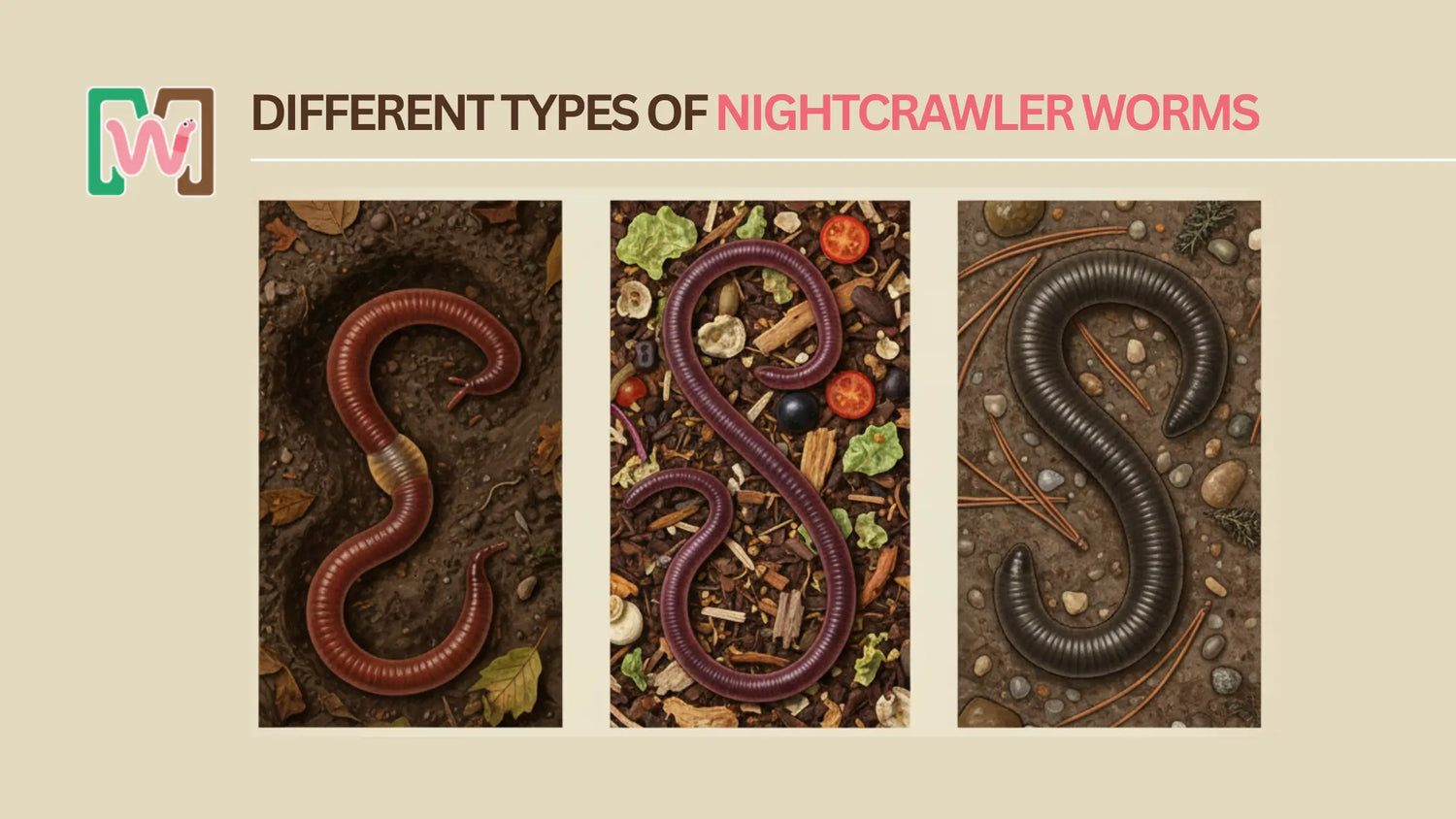Whether you want to generate vermicompost or want to aerate your soil, Nightcrawlers can come to your rescue. But, do you know there are different species of nightcrawler worms?
Most people don't! The post below will not only cover the different species but also help you know the differences between them. Let's first start with the very basics.
What are nightcrawlers?

Nightcrawlers are large worms that can grow as long as 14 inches. They often burrow the soil, which aids aeration, and also turn organic matter into worm castings, which is nothing but compost.
Now that you know what they do, it's time to understand how to identify them.
How to identify nightcrawlers?
Usually, nightcrawlers can be characterized by 3 things which are:
- Nightcrawlers are reddish brown or purple in color, usually 4 to 8 inches long.
- According to Purdue University, Nightcrawlers usually build large vertical burrows and stay inside them. The burrows can be 5' to 6' feet deep. They often lay castings above the burrows or at the start of burrows.
- The best time to spot them is between early to mid-spring.
What Are The Different Types of Nightcrawler Worms?
Essentially, Nightcrawlers can be classified into 3 species. The section below covers the 3 species and helps you identify them.
1. Canadian Nightcrawlers

Canadian Nightcrawlers are known by many names, like Lumbricus Terrestris, Dew Worms, etc. Their name comes from the fact that they are native to Canada.
- Physical characteristics
These worms are usually 6 to 8 inches long. The thickness is similar to that of a pencil. They have a tail which mimics a flat spade. The head is rounder and the clitellum is raised. If you are wondering what color such worms are, they are dark purple towards the head and the color fades as you progress towards the tail.
- Food
The good news is that, similar to most other worms, Canadian Nightcrawler worm does not require a special diet. They consume organic matter. The only requirement is that you feed them organic matter that isn't treated with chemicals or pesticides. This means you can feed them vegetable peels, fruits, crushed eggshells, and dried leaves. Just keep the citrus fruits away.
- Habitat
As highlighted above, Canadian Nightcrawlers are native to Canada, and therefore, they are accustomed to colder temperatures. The ideal soil temperature for them is 60°F. Apart from taking care of the soil temperature, keeping them shaded from the sun is important. As for moisture content, they do need moisture but in limited quantities. Any standing water is actually detrimental for them because, like most other worms, they breathe through the skin.
- Lifespan
Under ideal conditions, the lifespan of Canadian nightcrawlers can be as long as 8 years. However, much depends on the consistency of the food supply, moisture, and habitat. On average, the lifespan is around 3 years.
- Reproduction speed
The reproductive rate is a problem for Canadian Nightcrawlers. It can take them up to 18 months to mature sexually. To put things in perspective, most worm species mature sexually within 120 days. The reproduction rate for Canadian nightcrawlers is much slower.
Wondering how much is the reproduction rate?
Once they mature, a Canadian Nightcrawler can reproduce up to 15 worms annually.
- Use
Depending on the conditions, Canadian Nightcrawlers can be used for vermicomposting, but there are better alternatives than the Canadian nightcrawlers. One application in which they excel is usage as bait. Since they usually grow bigger than other worms, they are easily spotted by fish, which makes them effective baits.
2. European Nightcrawlers

European Nightcrawlers are certainly more popular than their Canadian counterparts. That's because their vermicomposting performance is pretty close to Red Wigglers. They are known by a variety of other names like Super Red worms, Eisenia Hortensis, and so on.
- Physical characteristics
Regarding physical appearance, European nightcrawlers can be red or dark pink. The average size of European Nightcrawlers is between 3 inches and 5 inches, which makes them the smallest among Nightcrawlers. The diameter of these worms is usually between 5 and 6mm. Their striped appearance makes them easily recognizable.
- Food
Similar to their Canadian counterparts, European Nightcrawlers also feast on organic matter. Apart from plant debris, they too consume paper, cardboard, and in some cases manure as well. While they can consume manure, it's best to feed them only aged manure. All in all, the diet of Canadian and European Nightcrawlers doesn't vary much.
- Habitat
The ideal temperature for European Nightcrawlers is between 60°F and 80°F. However, they are more tolerant to temperature variations than their Canadian counterparts. Above, we spoke about how Canadian Nightcrawlers mostly stay beneath the surface by burrowing deep. On the other hand, European ones spend a decent amount of time on the surface, but they also burrow deep. Since they prefer living in colonies and consume organic matter, a worm bin is certainly a good habitat for them.
- Lifespan
It's not uncommon for European Nightcrawlers to live for 5 years if the conditions are right. However, if you consider the average lifespan, that is around 3 years. The ideal conditions they need include:
- Ample moisture
- Fewer temperature fluctuations
- Habitat devoid of pests
- Plenty of organic matter devoid of toxins
That's pretty much the same for all 3 species of Nightcrawlers.
- Reproduction speed
The reproductive rate of European Nightcrawlers is much higher than that of Canadian ones. They usually lay one cocoon a week, and each cocoon produces an average of 1.5 hatchlings.
Since the hatchlings can reach sexual maturity within 20 weeks, their population can effectively double every 90 days. The only caveat is that there shouldn't be anything that disrupts this reproductive process. Therefore, ensure proper food supply and keep the bin pest-free.
- Use
European Nightcrawlers consume less food as compared to Red Wigglers, but they can consume food equal to half of their body weight on a daily basis. Therefore, they are a pretty good option for vermicomposting.
Another reason is that they burrow deep but are usually considered surface consumers, which means they break down the organic matter on the surface pretty well.
Additionally, they can handle a high carbon-to-nitrogen ratio, which once again means they can thrive in natural ecosystems and worm bins.
Apart from vermicomposting, they are often used as fishing bait.
Must Read : How Many Worms Do I Need For My Worm Bin?
3. African Nightcrawlers

Want a worm that can help you vermicompost in tropical climates?
If yes, you can go with the African Nightcrawler. The scientific name of these worms is Eudrilus Eugeniae. The only shortcoming of these worms is that they can't survive at lower temperatures.
Before you decide whether to add them to the worm bin or not, check out their characteristics below.
- Physical characteristics
African nightcrawlers have a unique combination of purple and gray color. Their average length is 5 to 7 inches, which means their size is between European and Canadian Nightcrawlers.
The diameter of these worms is usually less than their counterparts. You'll notice the same raised clitellum in these worms as a red wiggler. However, the clitellum is usually larger. When exposed to sunlight, their upper skin shines.
- Food
The best thing about African nightcrawlers is that they consume a lot of food including organic matter. Whether you feed them dried leaves, plants, or pieces of fruit or vegetables, they will devour them all. You can aid the consumption of organic matter simply by breaking down the organic matter into small pieces and feeding it to them.
- Habitat
The ideal habitat of African nightcrawlers is compost material and bedding which is appropriately moist. In a nutshell, the texture should be that of a wrung out sponge.
One thing that stands out about African nightcrawlers is that their optimal temperature is on the higher side, at 75°F. If you're looking for the range between 60°F and 90°F, that's the reason they are suitable for vermicomposting in tropical areas.
Keep in mind that temperatures below 50°F can prove fatal for them.
In natural surroundings, that is, a lawn or garden, they usually like to stay beneath the surface.
- Lifespan
The maximum lifespan of African Nightcrawlers is around 8 years. The average African Nightcrawler worm lifespan is usually in the range of 3 to 4 years. It means they certainly live a tad bit longer than their other counterparts. Once again, their lifespan depends on whether they experience ideal weather or not. The reason is that they can handle hot weather but not cold.
- Reproduction speed
Very few worm species can reproduce at a rate faster than Red Wigglers and African Nightcrawlers come pretty close. The reason is, they can lay 2 to 3 cocoons per week. An average cocoon consists of 2 to 3 babies which means 6 to 9 new worms in a week. Technically, Red Wigglers still reproduce faster but, you need to factor in the sexual maturity age.
African Nightcrawlers reach sexual maturity at least a week faster than Red Wigglers. This means that, on a net basis, African Nightcrawlers can reproduce faster or at the same rate as Red Wigglers.
- Use
African Nightcrawlers consume food equivalent to 1.5x their body weight. That's more than the 1x of Red Wigglers. They reproduce at the same rate as Red Wigglers or even faster. Additionally, African Nightcrawlers worm castings are often found near the surface which helps harvest them easily. Additionally, African Nightcrawler worm castings are also bigger which makes them easy to use. All these characteristics make them perfect worms for vermicomposting as long as you can protect them from low temperatures.
Their decent size also makes them a good choice as fishing bait. Sure enough, European and Canadian Nightcrawlers are thicker, but since fishes go for Red wigglers, which are thinner than Africans, African Nightcrawlers can be used as fishing bait.
Which Nightcrawlers are best suited for composting?
Out of the 3, there isn't a clear winner when it comes to vermicomposting. It depends on the conditions in your area. Below are 2 scenarios in which a different Nightcrawler species wins as the best vermicomposting worm.
Scenario 1: Warm climate

In warmer areas, where temperatures seldom drop below 50°F, you can choose African Nightcrawlers. They consume organic matter at a faster pace and can handle temperatures as high as 50°F. This means that if you live in Florida or other Southern regions, the African Nightcrawler wins.
Scenario 2: Colder climate

In regions with Colder climates, the European nightcrawler wins. The reason is that European nightcrawlers can handle temperature variations well and handle higher temperatures than Canadian nightcrawlers.
Must Read : Which are the Best Worms for Fishing? Lets Find Out
Difference between nightcrawlers vs earthworms
Truth be told, it isn't that easy to differentiate between Earthworms and Nightcrawlers. However, watch out for the signs below, and you can still differentiate between them.
- Usually nightcrawlers are darker than earthworms. Sure enough the exact color can vary depending on the species but the colors are darker.
- Touch an earthworm, and it will coil into a ball. Touch a nightcrawler, and it usually doesn't exhibit this behavior.
- If you have touched both, you'll notice that earthworms usually have softer skin. On the other hand, the skin of nightcrawlers is usually rough and thicker.
- Another difference is that nightcrawlers usually come out at night, hence their name. Simply put, they are nocturnal. Earthworms usually come out in the daytime.
Nightcrawler worm facts
Irrespective of which Nightcrawler species you go with, a few facts make them special.
1. They go pretty deep
According to National Geographic, It's not uncommon for Nightcrawlers to burrow as deep as 6.5'. There is significant advantage of this as it leads to better penetration of water, nutrients and air. That certainly helps them thrive. Such deep burrowing also means, Nightcrawlers can access the organic matter that is deep in the worm bin.
2. Named after their behavior
Nightcrawlers are widely known for surfacing, consuming organic matter, and mating at night, which is how they got their name.
3. Non-native
Irrespective of the Nightcrawlers species you choose, they aren't native to America. As is evident from their name, they belong to different parts of the world. Ideally, you should choose the species whose use aligns well with your purpose.
Can you use a combination of Nightcrawlers and Earthworms for vermicomposting?
Technically, yes you can. A combination of African Nightcrawlers and Red wigglers should work well in generating vermicompost during the initial few months of the worm bin. However, after that, the vermicompost generation won't accelerate at the same pace.
There is a reason for this.
According to a research report, cross-breeding will impact the reproduction rate and the efficiency of the hatchlings. This means a lot of energy will go waste without contributing to the population growth, which eventually means the compost production rate won't accelerate.
Exploring the Different Kinds of Worms: The Nightcrawler Family
Not all nightcrawlers are created equal. Understanding the different kinds of worms in this category is crucial for choosing the right one for your project. The three main species you will encounter are the European Nightcrawler, the African Nightcrawler, and the Canadian Nightcrawler. Each thrives in different environments and serves different primary purposes.
The European Nightcrawler: The All-Rounder Superstar
The European Nightcrawler (Eisenia hortensis), often called the "Dew Worm," is a favorite among worm enthusiasts for its versatility.
- Ideal For: composting and fishing.
- Size: A robust 3 to 4 inches long.
- Temperament: Hardy and adaptable, they can handle a wider range of temperatures than their relatives. They are excellent for composting systems and also make fantastic nightcrawler bait due to their size and lively movement in the water, which drives fish wild.
African Nightcrawlers: The Tropical Powerhouse
As the name suggests, Green Nightcrawlers (a common name for Eudrilus eugeniae) are a tropical species. They are known for their incredible size and rapid reproduction in the right conditions.
- Ideal For: Composting in warm climates and as a large bait option.
- Size: Can grow up to a massive 6-8 inches long.
- Temperament: They are extremely efficient composters but are highly sensitive to cold. They require temperatures above 60°F to thrive. For anglers in warm regions, these large green nightcrawlers are an irresistible nightcrawler bait for bigger fish.
Canadian Nightcrawler: The Legendary Fishing Bait
The Canadian Nightcrawler (Lumbricus terrestris) is the king of the bait shop. This is the giant worm most people picture when they think of nightcrawler bait.
- Ideal For: Fishing.
- Size: The largest of the common species, often reaching 6-10 inches.
- Temperament: These are cold-climate worms that require refrigeration to survive. They are not suitable for composting bins as they are deep burrowers and prefer cool, undisturbed soil. Their primary purpose is to be the ultimate nightcrawler fish attractant, with their large, wriggling body triggering strikes from game fish.
Beyond Nightcrawlers: Different Types of Earthworms
While we focus on nightcrawlers, it's helpful to understand the broader world of earthworms. The main different types of earthworms are categorized by their living habits:
- Epigeic Worms: These live on the surface in organic matter (like leaf litter). Red Wigglers are a perfect example and are the champions of vermicomposting.
- Endogeic Worms: These live in the topsoil and create horizontal burrows, feeding on soil and organic matter.
- Anecic Worms: This is the category that nightcrawler worm species like the Canadian Nightcrawler fall into. They create deep, vertical burrows and come to the surface to forage for organic matter.
Choosing the Right Bait: Why Nightcrawler Bait is a Top Choice
For anglers, the question isn't just "what worm?" but "what worm for which fish?". Using the right nightcrawler bait can make all the difference.
- European Nightcrawlers: Perfect for panfish, bass, and catfish. Their toughness means they stay on the hook longer.
- Canadian Nightcrawlers: The go-to for larger game fish like trout, walleye, and bass. Their dramatic movement is irresistible.
- African Nightcrawlers: Excellent for saltwater fishing or for targeting large freshwater fish, thanks to their substantial size.
No matter your target species, having a reliable source for quality nightcrawler bait is key to a successful fishing trip.
Must Read : How Do Worms Reproduce? A Complete Guide to Worm Mating, Cocoons and Growth
A Quick Guide to Types of Worms with Names
To summarize, here is a clear list of the primary types of worms with names discussed in this guide:
- European Nightcrawler (Eisenia hortensis): The versatile composter and angler's friend.
- African Nightcrawler (Eudrilus eugeniae): The large, tropical composting and bait worm.
- Canadian Nightcrawler (Lumbricus terrestris): The classic, large fishing bait worm.
Conclusion
Next time around, if you're looking to buy worms for vermicomposting, do give Nightcrawlers a thought. Instead of wondering What Are The Different Types of Nightcrawler Worms? simply check out the guide above, and you'll know which ones to choose and why.
Looking to start a worm bin? Don't forget to check out our Purebred European Nightcrawlers or Purebred Red Wigglers.




1 comment
Kieren
Canadian night crawlers are in fact, NOT from Canada. They are from western Europe and were not introduced to the americas until the 1700s.
Leave a comment
All comments are moderated before being published.
This site is protected by hCaptcha and the hCaptcha Privacy Policy and Terms of Service apply.